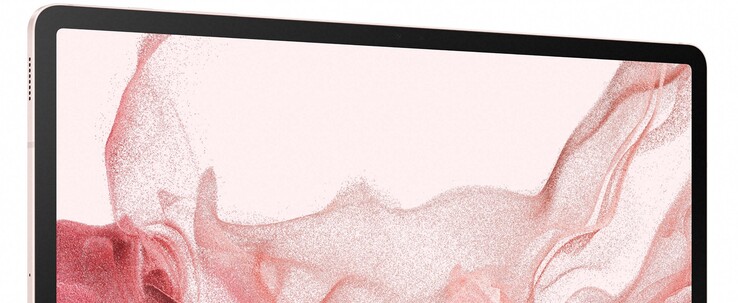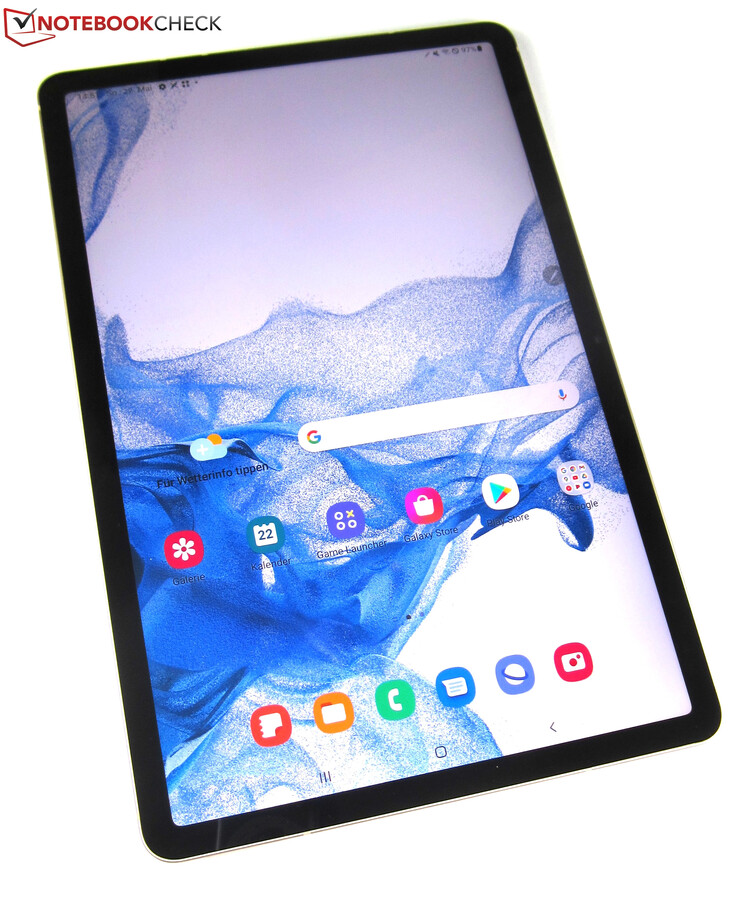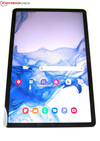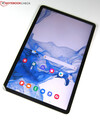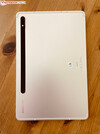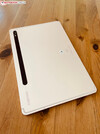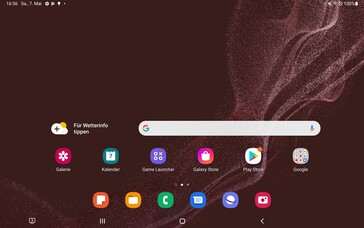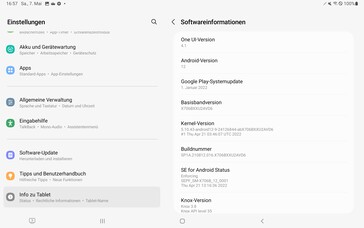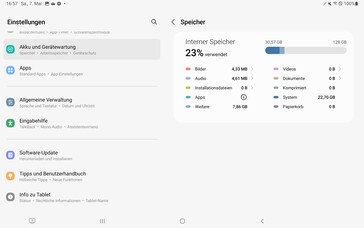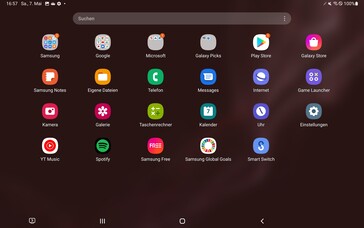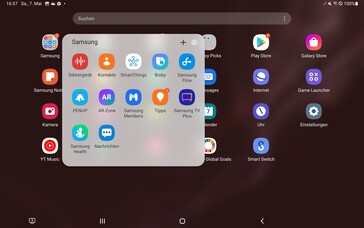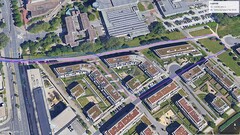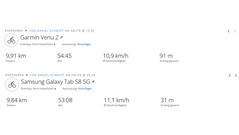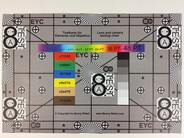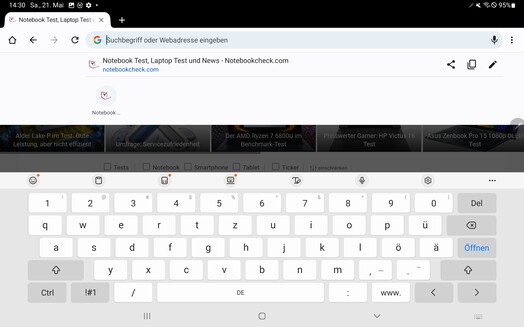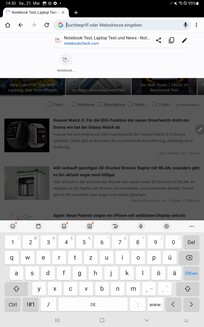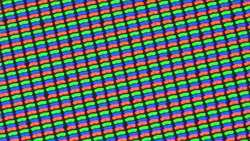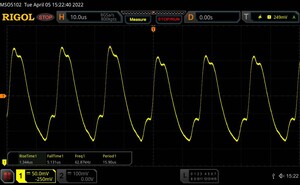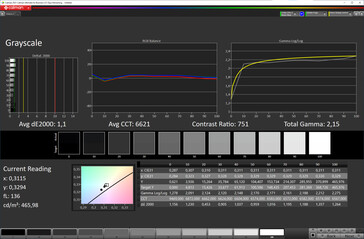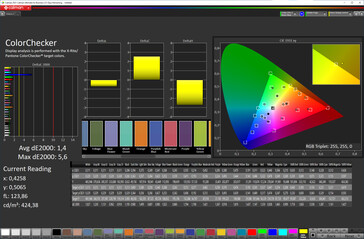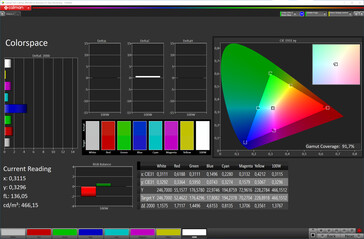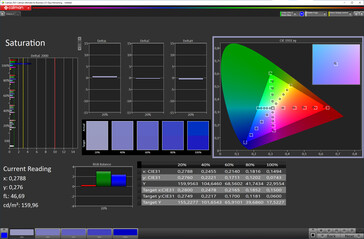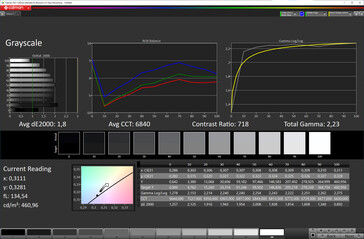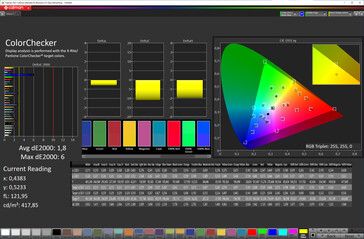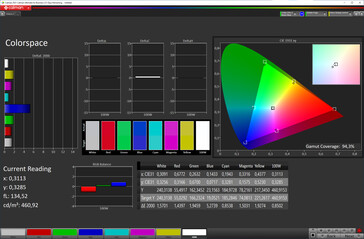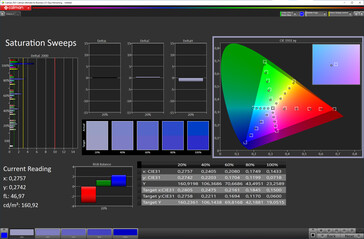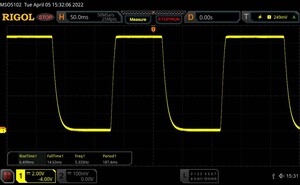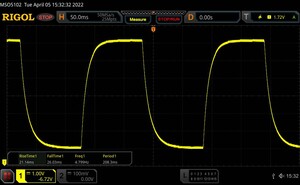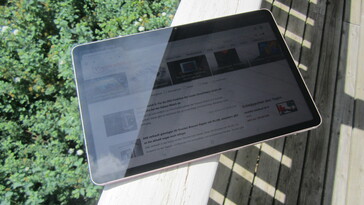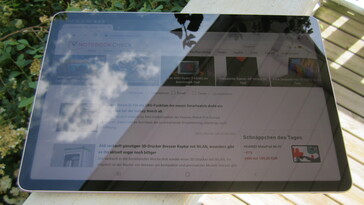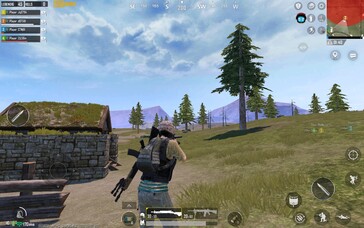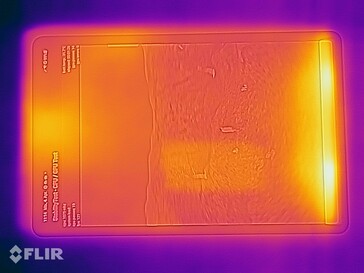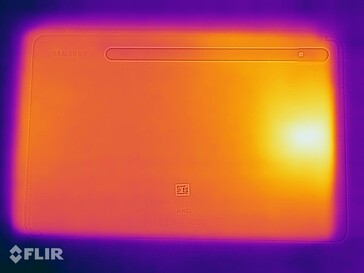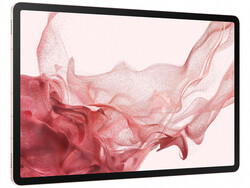Samsung Galaxy Tab S8 5G review: Maximum performance in 11-inch format
Samsung promises more productivity and creativity in everyday life with its Galaxy Tab S8 series. Buyers can choose between the 14.6-inch flagship Galaxy Tab S8 Ultra and the 12.4-inch Galaxy Tab S8+. The third tablet in the group is the Galaxy Tab S8, which has the most practical form factor with its 11-inch screen.
Like its sister models, the Galaxy Tab S8 also comes with Samsung's S Pen, the fast Snapdragon 8 Gen 1, and is offered in a Wi-Fi and a 5G version. We took a closer look at the 5G version, which is priced at just under 900 Euros in the smallest storage configuration (128 GB) in Samsung's online store. The 256 GB variant costs 950 Euros, while the Wi-Fi version is 150 Euros cheaper.
Note for international readers: The Galaxy Tab S8 is also available in other countries in various configurations at various prices (see "Price and Availability" at the end of this review for examples).
Possible Competitors in Comparison
Rating | Date | Model | Weight | Height | Size | Resolution | Price |
|---|---|---|---|---|---|---|---|
| 90.2 % v7 (old) | 06 / 2022 | Samsung Galaxy Tab S8 5G SD 8 Gen 1, Adreno 730 | 507 g | 6.3 mm | 11.00" | 2560x1600 | |
| 91.7 % v7 (old) | 03 / 2022 | Apple iPad Air 5 2022 M1, M1 8-Core GPU | 461 g | 6.1 mm | 10.90" | 2360x1640 | |
| 86.2 % v7 (old) | 04 / 2021 | Lenovo Tab P11 Pro SD 730G, Adreno 618 | 485 g | 5.8 mm | 11.50" | 2560x1600 | |
| 88.3 % v7 (old) | 04 / 2022 | Samsung Galaxy Tab S8+ 5G SD 8 Gen 1, Adreno 730 | 572 g | 5.7 mm | 12.40" | 2800x1752 | |
| 85.8 % v7 (old) | 08 / 2021 | Samsung Galaxy Tab S7 FE 5G SD 750G 5G, Adreno 619 | 608 g | 6.3 mm | 12.40" | 2560x1600 | |
| 88.7 % v7 (old) | 11 / 2021 | Xiaomi Pad 5 Pro SD 870, Adreno 650 | 515 g | 6.85 mm | 11.00" | 2560x1600 |
Case: High quality chassis out of aluminium and glass
Samsung's smallest Galaxy Tab S8 tablet makes an excellent impression in terms of look and feel with its even gaps, a "notch-less" webcam (as it is integrated directly into the frame) and the physical buttons that are firmly seated in the chassis.
Excluding the SIM slot and the side buttons, the chassis is made of Armor Aluminum, which not only gives the tablet a low weight of 507 grams, but also makes it scratch-resistant. If you wanted to, you could bend the tablet without too much effort, but it is more than sturdy enough for everyday use. This sturdiness also applies to the front of the Galaxy Tab S8 5G, which is protected by Gorilla Glass Victus+. The tablet is available in three color options: Graphite, Silver and Pink Gold.
The included Samsung S Pen attaches magnetically to both the top frame (next to the physical buttons) and the back. An area directly below the camera on the back cover for this purpose. The S Pen is also charged wirelessly there. No IP certification for protection against water and dust is provided.
Connectivity: Samsung S Pen and quad speakers
The Samsung Galaxy Tab S8 5G comes with an extensive set of features. This includes quad speakers with Dolby Atmos, a USB-C port with USB 3.2 Gen.1 speed, and the option to expand the internal storage with a microSD card of up to 1TB. In addition to all common microSD file formats, the tablet also supports the exFAT file format and can thus save files larger than 4GB. Wired image output is also possible via USB.
The Samsung delivers on its promise of productivity and creativity in more ways than one, with the S Pen stylus being the most obvious option. Another feature enables users to connect a Galaxy Book Cover Keyboard to the lower case side, which docks there magnetically. Screen sharing works via Miracast and is activated in the quick settings bar with the Smart View option. Furthermore, there is the second screen feature, which allows the tablet to function as a second screen for a Windows PC.
microSD Card Reader
When benchmarked with our Angelbird V60 reference card (read rate up to 280 MB/s, write rate up to 160 MB/s), the Samsung Galaxy Tab S8 achieves solid transfer rates that very much correspond to those of the Galaxy Tab S8+.
| SD Card Reader - average JPG Copy Test (av. of 3 runs) | |
| Samsung Galaxy Tab S8+ 5G (Angelbird AV Pro V60) | |
| Samsung Galaxy Tab S8 5G (Angelbird AV Pro V60) | |
| Samsung Galaxy Tab S7 FE 5G (Toshiba Exceria Pro M501) | |
| Lenovo Tab P11 Pro (Toshiba Exceria Pro M501) | |
Cross Platform Disk Test (CPDT)
Software: 5 years of security updates and Samsung DeX
Samsung is focusing on longevity for the Galaxy Tab S8 5G, promising up to four generations of Android OS upgrades as well as five years of security updates. No other manufacturer currently offers more in the field of Android devices.
The Galaxy Tab S8 5G runs Android 12 and Samsung's user interface OneUI in version 4.1. DeX, also known as "Desktop eXperience", provides users with a second user interface. It resembles Windows in terms of layout and operation and almost functions like a desktop OS when used with the S Pen and the optional Samsung Book Cover. The tablet can receive content from other compatible Samsung Galaxy devices via the Samsung Smart Switch.
At the time of testing (mid-May), the Android security updates were from May 2022 and therefore up to date. Another layer of security comes in the form of the Samsung Knox Vault platform, which protects sensitive data such as passwords from cyber attacks.
Communication and GNSS: 5G, WiFi 6E and Bluetooth 5.2
Samsung's Galaxy Tab S8 5G uses WiFi 6E just like the more expensive Galaxy Tab S8+ and Galaxy Tab S8 Ultra, a feature which is currently the major exception in the tablet sector. In combination with a WiFi 6E-capable router, such as the Asus ROG Rapture GT-AXE11000, it achieved very fast transfer rates under testing, peaking at 1802 Mbps. Data transfer remained just as stable in the WiFi 6 network and still achieved solid rates of more than 800 Mbit/s.
The 5G version of the Samsung Galaxy Tab S8 covers a wide frequency range with five 3G bands, 19 4G bands and 13 5G bands, so there should hardly be any reception issues. The tablet also supports Bluetooth 5.2, but not NFC.
| Networking | |
| iperf3 transmit AX12 | |
| Xiaomi Pad 5 Pro | |
| Apple iPad Air 5 2022 | |
| Lenovo Tab P11 Pro | |
| Samsung Galaxy Tab S7 FE 5G | |
| iperf3 receive AX12 | |
| Xiaomi Pad 5 Pro | |
| Apple iPad Air 5 2022 | |
| Samsung Galaxy Tab S7 FE 5G | |
| Lenovo Tab P11 Pro | |
| iperf3 receive AXE11000 | |
| Samsung Galaxy Tab S8+ 5G | |
| Apple iPad Air 5 2022 | |
| Samsung Galaxy Tab S8 5G | |
| iperf3 transmit AXE11000 | |
| Apple iPad Air 5 2022 | |
| Samsung Galaxy Tab S8+ 5G | |
| Samsung Galaxy Tab S8 5G | |
| iperf3 transmit AXE11000 6GHz | |
| Samsung Galaxy Tab S8 5G | |
| Samsung Galaxy Tab S8+ 5G | |
| iperf3 receive AXE11000 6GHz | |
| Samsung Galaxy Tab S8 5G | |
| Samsung Galaxy Tab S8+ 5G | |
Samsung's Galaxy Tab S8 5G uses satellite navigation services ranging from GPS (B1), Glonass (B1), Beidou (B1, B1C), Galileo (B1) to QZSS to determine its location. Under testing, the tablet determined its current position with an accuracy of 3 meters both indoors and outdoors, and localization functioned very quickly in both cases.
The tablet also provides accurate navigation data in practical use, as our short bike tour shows. Samsung's Galaxy Tab S8 5G tracks the almost 10-kilometer route almost as accurately as the Garmin Venu 2.
Cameras: Good dual camera with 13 MP
The selfie camera of the Galaxy Tab S8 5G has a resolution of 12 MP, delivers very solid image quality in daylight, and is therefore also well suited for video chats supported by auto-framing. In portrait mode, the selfie camera works with a bokeh effect. Unfortunately, the edges of the face are not displayed too sharply, so that there is no clear separation between the subject and the background
On the back is a dual camera consisting of a 13 MP wide-angle sensor with F2.0 aperture and a 6 MP ultra-wide-angle sensor (F2.2). In daylight, the main camera takes attractive photos that are rich and crisp in detail. In the photo lab, grayscale and colors are captured fairly accurately. Even with little residual light, the pictures produced are still detailed. The same cannot be said of other tablets, such as the Xiaomi Pad 5, which perform much worse here. The quality of the ultra-wide-angle camera lags a little behind that of the main camera, as peripheral areas are quite blurred and noisy.
Both the selfie camera and the main camera record videos at a maximum of 4K UHD at 30 frames per second, while the ultra-wide-angle camera is limited to FullHD at 30 FPS. Unlike the front camera, the rear dual camera works with video stabilization and delivers decent image quality. However, users cannot switch between the lenses during recording.
Image comparison
Choose a scene and navigate within the first image. One click changes the position on touchscreens. One click on the zoomed-in image opens the original in a new window. The first image shows the scaled photograph of the test device.
HauptkameraHauptkameraUltraweitwinkel5-facher ZoomLow-Light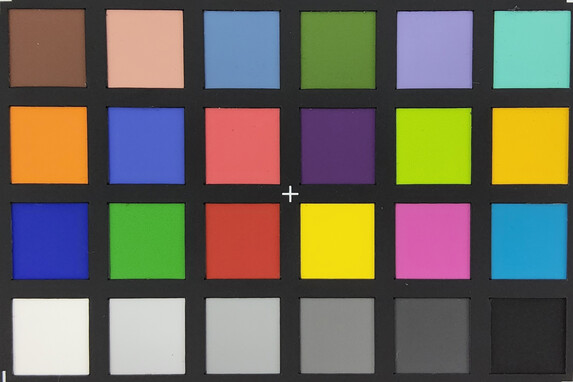
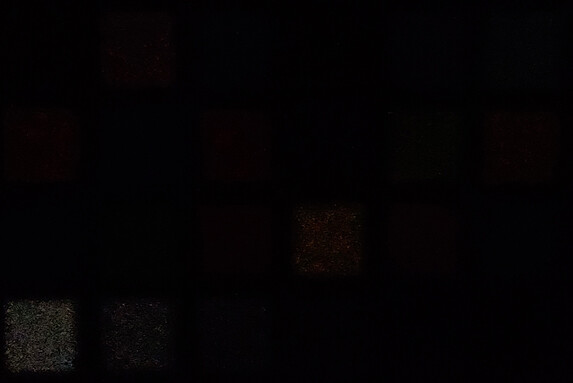
Accessories & Warranty: The 45-watt power supply costs extra
Upon purchase, Samsung Galaxy Tab S8 5G comes with the Samsung S Pen, a USB cable (Type C to Type C), a SIM tool as well as a quick-start guide and warranty information. Further accessories such as book covers, headphones and smartwatches can be purchased in Samsung's store. The matching 45-watt power supply adapter is also offered there for around 50 Euros.
In Germany, the Samsung Galaxy Tab S8 5G comes with a two-year warranty. Samsung also offers extended protection against damage and theft with its Care+ package, the costs of which may differ from region to region.
Input devices & Operation: Fingerprint sensor in the function key
Samsung's Galaxy Tab S8 5G implements inputs swiftly and precisely, regardless of whether they are made directly on the display or via the S Pen. Thanks to its adaptive refresh rate of up to 120 Hz, the tablet displays content very smoothly, giving the impression that it is not even remotely challenged by any task under testing.
The S Pen recognizes 4096 pressure levels, thus allowing for very precise writing and drawing. To create notes or sketches, you can tap the small pen icon on the right edge of the display and then start the note app. The pen menu can also be used to take screenshots and to furnish these with text. At the same time, it also functions as a quick launch bar because you can add other apps to the list.
The fingerprint sensor of the Galaxy Tab S8 5G is located in the Bixby or function key and unlocks the tablet reliably. Biometric authentication is also available via 2D face recognition, which also has a fast response time.
Display: Sharp and color accurate TFT screen
If we take pixel density as a benchmark, the Galaxy Tab S8 5G displays content on its 2560x1600 TFT screen at 274 PPI, which is sharper than the Galaxy Tab S8+ (266 PPI) and the Galaxy Tab S8 Ultra (239 PPI). It is also brighter than the comparison device average of 536 cd/m². A blue light filter can be enabled in the display settings for additional ease of use.
With evenly distributed bright and dark image areas (APL18), the TFT screen achieves a maximum luminance of 552 cd/m², remaining at 467 cd/m² with the brightness sensor disabled. At the lowest brightness setting, the display still shines with 6.78 cd/m² (5.38 cd/m² if extra dimming is enabled in the input settings). We did notice display flickering under testing, but this only occurs when the brightness is set to 2% or lower, so it should not be an issue in practice.
| |||||||||||||||||||||||||
Brightness Distribution: 93 %
Center on Battery: 551 cd/m²
Contrast: 918:1 (Black: 0.6 cd/m²)
ΔE ColorChecker Calman: 1.4 | ∀{0.5-29.43 Ø4.77}
ΔE Greyscale Calman: 1.1 | ∀{0.09-98 Ø5}
91.7% sRGB (Calman 2D)
Gamma: 2.15
CCT: 6621 K
| Samsung Galaxy Tab S8 5G LCD, 2560x1600, 11" | Apple iPad Air 5 2022 IPS, 2360x1640, 10.9" | Lenovo Tab P11 Pro OLED, 2560x1600, 11.5" | Samsung Galaxy Tab S8+ 5G Super AMOLED, 2800x1752, 12.4" | Samsung Galaxy Tab S7 FE 5G LCD IPS, 2560x1600, 12.4" | Xiaomi Pad 5 Pro IPS, 2560x1600, 11" | |
|---|---|---|---|---|---|---|
| Screen | 5% | -37% | -50% | -10% | -4% | |
| Brightness middle (cd/m²) | 551 | 529 -4% | 372 -32% | 459 -17% | 619 12% | 497 -10% |
| Brightness (cd/m²) | 536 | 490 -9% | 375 -30% | 462 -14% | 593 11% | 475 -11% |
| Brightness Distribution (%) | 93 | 86 -8% | 95 2% | 97 4% | 91 -2% | 89 -4% |
| Black Level * (cd/m²) | 0.6 | 0.37 38% | 0.22 63% | 0.42 30% | ||
| Contrast (:1) | 918 | 1430 56% | 2814 207% | 1183 29% | ||
| Colorchecker dE 2000 * | 1.4 | 1.35 4% | 1.8 -29% | 2.2 -57% | 2.6 -86% | 1.4 -0% |
| Colorchecker dE 2000 max. * | 5.6 | 2.45 56% | 4.2 25% | 4.9 12% | 6.6 -18% | 3 46% |
| Greyscale dE 2000 * | 1.1 | 2.1 -91% | 2.8 -155% | 3.6 -227% | 4 -264% | 2.3 -109% |
| Gamma | 2.15 102% | 2.183 101% | 2.29 96% | 2.09 105% | 2.17 101% | 2.25 98% |
| CCT | 6621 98% | 6939 94% | 6718 97% | 6558 99% | 6973 93% | 6744 96% |
* ... smaller is better
Screen Flickering / PWM (Pulse-Width Modulation)
| Screen flickering / PWM detected | 62870 Hz | ≤ 2 % brightness setting | |
The display backlight flickers at 62870 Hz (worst case, e.g., utilizing PWM) Flickering detected at a brightness setting of 2 % and below. There should be no flickering or PWM above this brightness setting. The frequency of 62870 Hz is quite high, so most users sensitive to PWM should not notice any flickering. In comparison: 53 % of all tested devices do not use PWM to dim the display. If PWM was detected, an average of 8084 (minimum: 5 - maximum: 343500) Hz was measured. | |||
Messreihe mit fixer Zoomstufe und unterschiedlichen Helligkeitseinstellungen
The preset image modes "Vivid" and "Natural" can be selected in the display settings. The latter provides the most accurate color reproduction, even though it only covers the smaller sRGB color space instead of the DCI-P3 color space. Color fidelity in "Natural" image mode with a maximum Delta-E of 1.4 falls into the ideal range, as well as color temperature and RGB balance.
Display Response Times
| ↔ Response Time Black to White | ||
|---|---|---|
| 10.56 ms ... rise ↗ and fall ↘ combined | ↗ 6.499 ms rise | |
| ↘ 14.63 ms fall | ||
| The screen shows good response rates in our tests, but may be too slow for competitive gamers. In comparison, all tested devices range from 0.1 (minimum) to 240 (maximum) ms. » 28 % of all devices are better. This means that the measured response time is better than the average of all tested devices (20.2 ms). | ||
| ↔ Response Time 50% Grey to 80% Grey | ||
| 47.17 ms ... rise ↗ and fall ↘ combined | ↗ 21.14 ms rise | |
| ↘ 26.03 ms fall | ||
| The screen shows slow response rates in our tests and will be unsatisfactory for gamers. In comparison, all tested devices range from 0.165 (minimum) to 636 (maximum) ms. » 81 % of all devices are better. This means that the measured response time is worse than the average of all tested devices (31.6 ms). | ||
Performance: Samsung tablet with Snapdragon 8 Gen 1
Samsung's Galaxy Tab S8 5G is equipped with the fastest Android SoC, the Snapdragon 8 Gen 1 and its Adreno 730 GPU. The tablet thus sails through our benchmark measurements with ease. In the synthetic benchmarks, it is almost always at the forefront, scoring 927000 points in AnTuTu v9 for example. However, like all other tablets with Snapdragon 8 Gen 1, it is forced to concede defeat to the Apple iPad Air 5 2022 and its Apple M1. The AI calculations are also not very good for the Android SoC, as can be seen in its AImark scores.
Samsung's Galaxy Tab S8 5G also proves to be one of the fastest Android tablets in the GPU-heavy tests. In GFXBench in particular, it can fully exploit the potential of its 120 Hz screen. The Apple iPad Air 5 2022 still performs a bit better in 3DMark Wild Life.
GFXBench (DX / GLBenchmark) 2.7: T-Rex Onscreen | 1920x1080 T-Rex Offscreen
GFXBench 3.0: on screen Manhattan Onscreen OGL | 1920x1080 1080p Manhattan Offscreen
GFXBench 3.1: on screen Manhattan ES 3.1 Onscreen | 1920x1080 Manhattan ES 3.1 Offscreen
GFXBench: on screen Car Chase Onscreen | 1920x1080 Car Chase Offscreen | on screen Aztec Ruins High Tier Onscreen | 2560x1440 Aztec Ruins High Tier Offscreen | on screen Aztec Ruins Normal Tier Onscreen | 1920x1080 Aztec Ruins Normal Tier Offscreen
| 3DMark / Wild Life Extreme Unlimited | |
| Apple iPad Air 5 2022 | |
| Samsung Galaxy Tab S8+ 5G | |
| Samsung Galaxy Tab S8 5G | |
| Xiaomi Pad 5 Pro | |
| Samsung Galaxy Tab S7 FE 5G | |
| 3DMark / Wild Life Extreme | |
| Apple iPad Air 5 2022 | |
| Samsung Galaxy Tab S8+ 5G | |
| Samsung Galaxy Tab S8 5G | |
| Xiaomi Pad 5 Pro | |
| Samsung Galaxy Tab S7 FE 5G | |
| 3DMark / Wild Life Unlimited Score | |
| Apple iPad Air 5 2022 | |
| Samsung Galaxy Tab S8 5G | |
| Samsung Galaxy Tab S8+ 5G | |
| Xiaomi Pad 5 Pro | |
| Samsung Galaxy Tab S7 FE 5G | |
| Lenovo Tab P11 Pro | |
| 3DMark / Wild Life Score | |
| Apple iPad Air 5 2022 | |
| Samsung Galaxy Tab S8+ 5G | |
| Samsung Galaxy Tab S8 5G | |
| Xiaomi Pad 5 Pro | |
| Samsung Galaxy Tab S7 FE 5G | |
| Lenovo Tab P11 Pro | |
| 3DMark / Sling Shot OpenGL ES 3.0 Unlimited | |
| Xiaomi Pad 5 Pro | |
| Samsung Galaxy Tab S8 5G | |
| Samsung Galaxy Tab S8+ 5G | |
| Samsung Galaxy Tab S8+ 5G | |
| Samsung Galaxy Tab S7 FE 5G | |
| Lenovo Tab P11 Pro | |
| 3DMark / Sling Shot OpenGL ES 3.0 Unlimited Graphics | |
| Samsung Galaxy Tab S8 5G | |
| Samsung Galaxy Tab S8+ 5G | |
| Samsung Galaxy Tab S8+ 5G | |
| Xiaomi Pad 5 Pro | |
| Samsung Galaxy Tab S7 FE 5G | |
| Lenovo Tab P11 Pro | |
| 3DMark / Sling Shot OpenGL ES 3.0 Unlimited Physics | |
| Xiaomi Pad 5 Pro | |
| Samsung Galaxy Tab S8+ 5G | |
| Samsung Galaxy Tab S8+ 5G | |
| Samsung Galaxy Tab S8 5G | |
| Samsung Galaxy Tab S7 FE 5G | |
| Lenovo Tab P11 Pro | |
| 3DMark / Sling Shot Extreme (ES 3.1) Unlimited | |
| Samsung Galaxy Tab S8 5G | |
| Xiaomi Pad 5 Pro | |
| Samsung Galaxy Tab S8+ 5G | |
| Samsung Galaxy Tab S7 FE 5G | |
| Lenovo Tab P11 Pro | |
| 3DMark / Sling Shot Extreme (ES 3.1) Unlimited Graphics | |
| Samsung Galaxy Tab S8 5G | |
| Samsung Galaxy Tab S8+ 5G | |
| Xiaomi Pad 5 Pro | |
| Samsung Galaxy Tab S7 FE 5G | |
| Lenovo Tab P11 Pro | |
| 3DMark / Sling Shot Extreme (ES 3.1) Unlimited Physics | |
| Xiaomi Pad 5 Pro | |
| Samsung Galaxy Tab S8 5G | |
| Samsung Galaxy Tab S8+ 5G | |
| Samsung Galaxy Tab S7 FE 5G | |
| Lenovo Tab P11 Pro | |
| GFXBench (DX / GLBenchmark) 2.7 / T-Rex Onscreen | |
| Samsung Galaxy Tab S8 5G | |
| Xiaomi Pad 5 Pro | |
| Samsung Galaxy Tab S8+ 5G | |
| Apple iPad Air 5 2022 | |
| Lenovo Tab P11 Pro | |
| Samsung Galaxy Tab S7 FE 5G | |
| GFXBench (DX / GLBenchmark) 2.7 / T-Rex Offscreen | |
| Apple iPad Air 5 2022 | |
| Samsung Galaxy Tab S8 5G | |
| Samsung Galaxy Tab S8+ 5G | |
| Xiaomi Pad 5 Pro | |
| Lenovo Tab P11 Pro | |
| Samsung Galaxy Tab S7 FE 5G | |
| GFXBench 3.0 / Manhattan Onscreen OGL | |
| Samsung Galaxy Tab S8 5G | |
| Samsung Galaxy Tab S8+ 5G | |
| Xiaomi Pad 5 Pro | |
| Apple iPad Air 5 2022 | |
| Lenovo Tab P11 Pro | |
| Samsung Galaxy Tab S7 FE 5G | |
| GFXBench 3.0 / 1080p Manhattan Offscreen | |
| Apple iPad Air 5 2022 | |
| Samsung Galaxy Tab S8 5G | |
| Samsung Galaxy Tab S8+ 5G | |
| Xiaomi Pad 5 Pro | |
| Samsung Galaxy Tab S7 FE 5G | |
| Lenovo Tab P11 Pro | |
| GFXBench 3.1 / Manhattan ES 3.1 Onscreen | |
| Samsung Galaxy Tab S8 5G | |
| Apple iPad Air 5 2022 | |
| Samsung Galaxy Tab S8+ 5G | |
| Xiaomi Pad 5 Pro | |
| Lenovo Tab P11 Pro | |
| Samsung Galaxy Tab S7 FE 5G | |
| GFXBench 3.1 / Manhattan ES 3.1 Offscreen | |
| Apple iPad Air 5 2022 | |
| Samsung Galaxy Tab S8 5G | |
| Samsung Galaxy Tab S8+ 5G | |
| Xiaomi Pad 5 Pro | |
| Samsung Galaxy Tab S7 FE 5G | |
| Lenovo Tab P11 Pro | |
| GFXBench / Car Chase Onscreen | |
| Apple iPad Air 5 2022 | |
| Samsung Galaxy Tab S8 5G | |
| Samsung Galaxy Tab S8+ 5G | |
| Xiaomi Pad 5 Pro | |
| Samsung Galaxy Tab S7 FE 5G | |
| Lenovo Tab P11 Pro | |
| GFXBench / Car Chase Offscreen | |
| Apple iPad Air 5 2022 | |
| Samsung Galaxy Tab S8 5G | |
| Samsung Galaxy Tab S8+ 5G | |
| Xiaomi Pad 5 Pro | |
| Samsung Galaxy Tab S7 FE 5G | |
| Lenovo Tab P11 Pro | |
| GFXBench / Aztec Ruins High Tier Onscreen | |
| Apple iPad Air 5 2022 | |
| Samsung Galaxy Tab S8 5G | |
| Samsung Galaxy Tab S8+ 5G | |
| Xiaomi Pad 5 Pro | |
| Samsung Galaxy Tab S7 FE 5G | |
| Lenovo Tab P11 Pro | |
| GFXBench / Aztec Ruins High Tier Offscreen | |
| Apple iPad Air 5 2022 | |
| Samsung Galaxy Tab S8+ 5G | |
| Samsung Galaxy Tab S8 5G | |
| Xiaomi Pad 5 Pro | |
| Samsung Galaxy Tab S7 FE 5G | |
| Lenovo Tab P11 Pro | |
| GFXBench / Aztec Ruins Normal Tier Onscreen | |
| Apple iPad Air 5 2022 | |
| Samsung Galaxy Tab S8 5G | |
| Samsung Galaxy Tab S8+ 5G | |
| Xiaomi Pad 5 Pro | |
| Lenovo Tab P11 Pro | |
| Samsung Galaxy Tab S7 FE 5G | |
| GFXBench / Aztec Ruins Normal Tier Offscreen | |
| Apple iPad Air 5 2022 | |
| Samsung Galaxy Tab S8+ 5G | |
| Samsung Galaxy Tab S8 5G | |
| Xiaomi Pad 5 Pro | |
| Samsung Galaxy Tab S7 FE 5G | |
| Lenovo Tab P11 Pro | |
The Galaxy Tab S8 5G is also at the top in terms of browser performance. Websites load very quickly and there were no delays or other unexpected pauses under testing.
| Jetstream 2 - 2.0 Total Score | |
| Apple iPad Air 5 2022 (Safari 15) | |
| Average of class Tablet (22.3 - 395, n=68, last 2 years) | |
| Samsung Galaxy Tab S8 5G (Chrome 101.0.4951.41) | |
| Average Qualcomm Snapdragon 8 Gen 1 (72.8 - 134.6, n=16) | |
| Samsung Galaxy Tab S8+ 5G (Samsung Browser V16) | |
| Xiaomi Pad 5 Pro (Chrome 94.0.4606.85) | |
| Samsung Galaxy Tab S7 FE 5G (Chrome91) | |
| Lenovo Tab P11 Pro (Chrome 89.0.4389.105) | |
| JetStream 1.1 - Total Score | |
| Apple iPad Air 5 2022 (Safari 15) | |
| Samsung Galaxy Tab S8 5G (Chrome 101.0.4951.41) | |
| Samsung Galaxy Tab S8+ 5G | |
| Samsung Galaxy Tab S8+ 5G | |
| Average Qualcomm Snapdragon 8 Gen 1 (121.9 - 237, n=11) | |
| Xiaomi Pad 5 Pro (Chrome 94.0.4606.85) | |
| Samsung Galaxy Tab S7 FE 5G (Chrome91) | |
| Lenovo Tab P11 Pro (Chrome 89.0.4389.105) | |
| WebXPRT 3 - Overall | |
| Apple iPad Air 5 2022 (Safari 15) | |
| Average of class Tablet (39 - 480, n=24, last 2 years) | |
| Samsung Galaxy Tab S8 5G (Chrome 101.0.4951.41) | |
| Samsung Galaxy Tab S8+ 5G (Samsung Browser V16) | |
| Average Qualcomm Snapdragon 8 Gen 1 (79 - 193, n=15) | |
| Xiaomi Pad 5 Pro (Chrome 94.0.4606.85) | |
| Samsung Galaxy Tab S7 FE 5G (Chrome91) | |
| Lenovo Tab P11 Pro (Chrome 89.0.4389.105) | |
| Speedometer 2.0 - Result 2.0 | |
| Apple iPad Air 5 2022 (Safari 15) | |
| Average of class Tablet (2.59 - 790, n=54, last 2 years) | |
| Samsung Galaxy Tab S8 5G (Chrome 101.0.4951.41) | |
| Average Qualcomm Snapdragon 8 Gen 1 (64.4 - 129.3, n=16) | |
| Samsung Galaxy Tab S8+ 5G (Samsung Browser V16) | |
| Xiaomi Pad 5 Pro (Chrome 94.0.4606.85) | |
| Samsung Galaxy Tab S7 FE 5G (Chrome91) | |
| Lenovo Tab P11 Pro (Chrome 89.0.4389.105) | |
| Octane V2 - Total Score | |
| Apple iPad Air 5 2022 (Safari 15) | |
| Samsung Galaxy Tab S8 5G (Chrome 101.0.4951.41) | |
| Average of class Tablet (763 - 138481, n=94, last 2 years) | |
| Average Qualcomm Snapdragon 8 Gen 1 (27730 - 50626, n=17) | |
| Samsung Galaxy Tab S8+ 5G (Samsung Browser V16) | |
| Xiaomi Pad 5 Pro (Chrome 94.0.4606.85) | |
| Samsung Galaxy Tab S7 FE 5G (Chrome91) | |
| Lenovo Tab P11 Pro (Chrome 89.0.4389.105) | |
| Mozilla Kraken 1.1 - Total | |
| Lenovo Tab P11 Pro (Chrome 89.0.4389.105) | |
| Average of class Tablet (243 - 27101, n=79, last 2 years) | |
| Samsung Galaxy Tab S7 FE 5G (Chrome91) | |
| Xiaomi Pad 5 Pro (Chrome 94.0.4606.85) | |
| Average Qualcomm Snapdragon 8 Gen 1 (814 - 1440, n=16) | |
| Samsung Galaxy Tab S8+ 5G (Samsung Browser V16) | |
| Samsung Galaxy Tab S8 5G (Chrome 101.0.4951.41) | |
| Apple iPad Air 5 2022 (Safari 15) | |
* ... smaller is better
The UFS 3.1 device of Samsung's Galaxy Tab S8 5G ensures short loading times. The 4K random reads/writes are even above average.
| Samsung Galaxy Tab S8 5G | Lenovo Tab P11 Pro | Samsung Galaxy Tab S8+ 5G | Samsung Galaxy Tab S7 FE 5G | Xiaomi Pad 5 Pro | Average 128 GB UFS 3.1 Flash | Average of class Tablet | |
|---|---|---|---|---|---|---|---|
| AndroBench 3-5 | -62% | 3% | -39% | 2% | -9% | 13% | |
| Sequential Read 256KB (MB/s) | 1517.98 | 486.8 -68% | 1726.34 14% | 861 -43% | 1684 11% | 1569 ? 3% | 1786 ? 18% |
| Sequential Write 256KB (MB/s) | 1026.82 | 192.3 -81% | 1374.65 34% | 512 -50% | 772 -25% | 768 ? -25% | 1337 ? 30% |
| Random Read 4KB (MB/s) | 263.23 | 136.3 -48% | 202.35 -23% | 192 -27% | 289.3 10% | 244 ? -7% | 246 ? -7% |
| Random Write 4KB (MB/s) | 256.83 | 123.3 -52% | 218.02 -15% | 167.5 -35% | 281.5 10% | 243 ? -5% | 279 ? 9% |
| AndroBench 3-5 | |
| Samsung Galaxy Tab S8 5G | |
| Sequential Read 256KB | |
| Sequential Write 256KB | |
| Random Read 4KB | |
| Random Write 4KB | |
| Samsung Galaxy Tab S8+ 5G | |
| Sequential Read 256KB | |
| Sequential Write 256KB | |
| Random Read 4KB | |
| Random Write 4KB | |
| Xiaomi Pad 5 Pro | |
| Sequential Read 256KB | |
| Sequential Write 256KB | |
| Random Read 4KB | |
| Random Write 4KB | |
| Samsung Galaxy Tab S7 FE 5G | |
| Sequential Read 256KB | |
| Sequential Write 256KB | |
| Random Read 4KB | |
| Random Write 4KB | |
| Lenovo Tab P11 Pro | |
| Sequential Read 256KB | |
| Sequential Write 256KB | |
| Random Read 4KB | |
| Random Write 4KB | |
| Average of class Tablet | |
| Sequential Read 256KB | |
| Sequential Write 256KB | |
| Random Read 4KB | |
| Random Write 4KB | |
Gaming: Strong gaming platform
The Snapdragon 8 Gen 1, four speakers and the 120 Hz screen make the Galaxy Tab S8 5G a powerful gaming machine. The test games, whose frame rates we determined with the Gamebench tool, all ran wonderfully smoothly and were accompanied by strong surround sound.
However, the tablet cannot fully take advantage of the 120 Hz screen in gaming. More than 60 frames per second were not possible in Armajet and PUBG Mobile (graphics settings HD/High). The Galaxy Tab S8+ and the Galaxy Tab S8 Ultra occasionally achieve significantly higher FPS numbers here.
Emissions: Powerful surround sound
Temperature
In operation, the Galaxy Tab S8 5G stays well below the 30 °C mark even under constant load and is thus never uncomfortably warm. Because a Snapdragon 8 Gen 1 is used in the tablet, throttling is virtually inevitable. Then again, the throttling that occurs under load is not quite as pronounced as in many smartphones equipped with the same SoC thanks to the larger case. Moreover, as there is still so much residual power to draw from, users do not notice the throttling under normal use.
3DMark Wild Life Stress Test
(+) The maximum temperature on the upper side is 30.5 °C / 87 F, compared to the average of 33.6 °C / 92 F, ranging from 20.7 to 53.2 °C for the class Tablet.
(+) The bottom heats up to a maximum of 31.1 °C / 88 F, compared to the average of 33.2 °C / 92 F
(+) In idle usage, the average temperature for the upper side is 27.8 °C / 82 F, compared to the device average of 30 °C / 86 F.
Speakers
There are a total of four Dolby Atmos speakers on the two narrow sides of the Galaxy Tab S8 5G, which can play up to a loud 89.4 dB(A) and produce powerful sound with very balanced mids and trebles. Although the bass tones are lacking somewhat, they are still much more pronounced in the sound mix than in many other tablets.
Since the Galaxy Tab S8 5G lacks a 3.5mm jack, wired audio devices such as headsets have to be connected via a USB-C adapter, which Samsung does not include with its tablet. The Bluetooth audio codecs AAC, aptX, LDAC and SBC are available for audio output via Bluetooth 5.2, which is a somewhat sparse selection.
Samsung Galaxy Tab S8 5G audio analysis
(+) | speakers can play relatively loud (89.4 dB)
Bass 100 - 315 Hz
(-) | nearly no bass - on average 16.5% lower than median
(±) | linearity of bass is average (8.9% delta to prev. frequency)
Mids 400 - 2000 Hz
(+) | balanced mids - only 2.9% away from median
(+) | mids are linear (4.3% delta to prev. frequency)
Highs 2 - 16 kHz
(+) | balanced highs - only 4.4% away from median
(±) | linearity of highs is average (7.2% delta to prev. frequency)
Overall 100 - 16.000 Hz
(+) | overall sound is linear (13.5% difference to median)
Compared to same class
» 26% of all tested devices in this class were better, 4% similar, 70% worse
» The best had a delta of 7%, average was 20%, worst was 129%
Compared to all devices tested
» 14% of all tested devices were better, 4% similar, 83% worse
» The best had a delta of 4%, average was 24%, worst was 134%
Apple iPad Air 5 2022 audio analysis
(+) | speakers can play relatively loud (84.8 dB)
Bass 100 - 315 Hz
(±) | reduced bass - on average 11.1% lower than median
(±) | linearity of bass is average (11.4% delta to prev. frequency)
Mids 400 - 2000 Hz
(+) | balanced mids - only 2.8% away from median
(+) | mids are linear (3.1% delta to prev. frequency)
Highs 2 - 16 kHz
(±) | higher highs - on average 6.2% higher than median
(+) | highs are linear (5.5% delta to prev. frequency)
Overall 100 - 16.000 Hz
(+) | overall sound is linear (12.4% difference to median)
Compared to same class
» 19% of all tested devices in this class were better, 5% similar, 76% worse
» The best had a delta of 7%, average was 20%, worst was 129%
Compared to all devices tested
» 10% of all tested devices were better, 2% similar, 88% worse
» The best had a delta of 4%, average was 24%, worst was 134%
Energy Management: The Galaxy Tab S8 with the best battery life
Power Consumption
The smallest tablet from Samsung's Galaxy Tab S8 lineup also has the smallest battery: a 8000 mAh battery that can be charged with a maximum of 45 watts. The corresponding power adapter is only available for a surcharge and costs around 50 Euros in Samsung's web store (prices may vary slightly in the currencies of other regions).
The Galaxy Tab S8 5G is restrained in terms of power consumption. In contrast to the comparison devices, it consumes noticeably less power, especially when idling, and is thus much more balanced.
| Off / Standby | |
| Idle | |
| Load |
|
Key:
min: | |
| Samsung Galaxy Tab S8 5G 8000 mAh | Apple iPad Air 5 2022 mAh | Lenovo Tab P11 Pro 8600 mAh | Samsung Galaxy Tab S8+ 5G 10090 mAh | Samsung Galaxy Tab S7 FE 5G 10090 mAh | Xiaomi Pad 5 Pro 8600 mAh | |
|---|---|---|---|---|---|---|
| Power Consumption | -62% | -3% | -35% | -26% | -10% | |
| Idle Minimum * (Watt) | 1.19 | 1.65 -39% | 1.55 -30% | 3.08 -159% | 1.06 11% | 1.14 4% |
| Idle Average * (Watt) | 4.38 | 8.1 -85% | 4.91 -12% | 3.69 16% | 6.25 -43% | 4.3 2% |
| Idle Maximum * (Watt) | 4.45 | 9.4 -111% | 5.02 -13% | 3.76 16% | 6.3 -42% | 4.31 3% |
| Load Average * (Watt) | 7.85 | 9.5 -21% | 4.38 44% | 7.72 2% | 8.76 -12% | 8.09 -3% |
| Load Maximum * (Watt) | 6.67 | 10.4 -56% | 6.81 -2% | 9.87 -48% | 9.54 -43% | 10.32 -55% |
* ... smaller is better
Power Consumption: Geekbench (150 cd/m²)
Power Consumption: GFXBench (150 cd/m²)
Battery Life
The Galaxy Tab S8 5G makes optimal use of its 8000 mAh battery because it achieves much longer battery runtimes than its sister models, the Galaxy Tab S8+ and Galaxy Tab S8 Ultra. Both have larger batteries (10090 and 11220 mAh), but they also have to power significantly larger displays.
Overall, the Galaxy Tab S8 5G runs about a third longer than the other Galaxy Tab S8 models, lasting for around 16 hours during simulated web browsing and almost 14 hours when playing video.
| Samsung Galaxy Tab S8 5G 8000 mAh | Apple iPad Air 5 2022 mAh | Lenovo Tab P11 Pro 8600 mAh | Samsung Galaxy Tab S8+ 5G 10090 mAh | Samsung Galaxy Tab S7 FE 5G 10090 mAh | Xiaomi Pad 5 Pro 8600 mAh | |
|---|---|---|---|---|---|---|
| Battery runtime | -29% | -13% | -37% | 19% | 9% | |
| Reader / Idle (h) | 36.2 | 27.4 -24% | 14.1 -61% | 41.4 14% | 50.2 39% | |
| H.264 (h) | 13.9 | 14.2 2% | 10.1 -27% | 20.8 50% | 16.8 21% | |
| WiFi v1.3 (h) | 16.1 | 10.8 -33% | 10.4 -35% | 7.3 -55% | 17 6% | 15.4 -4% |
| Load (h) | 5.5 | 4.1 -25% | 5.8 5% | 5.2 -5% | 5.7 4% | 4.3 -22% |
Pros
Cons
Verdict on the Samsung Galaxy Tab S8 5G
The Samsung Galaxy Tab S8 5G is one of the best Android tablets on the market. At 11 inches, it is the smallest tablet in the Galaxy Tab S8 lineup, but apart from the form factor and display, it differs from the larger and more expensive Galaxy Tab S8+ and Galaxy Tab S8 Ultra in surprisingly few ways.
The Samsung Galaxy Tab S8 5G employs the same camera, comes with the promise of future updates from Samsung (4 years of OS upgrades, 5 years of security updates), uses the same high-end SoC with the Snapdragon 8 Gen 1, and supports fast charging with up to 45 watts. In addition, there is also the intuitive Samsung S Pen, which turns the Android tablet into a creative station as promised by Samsung. Samsung's DeX desktop mode can be fully utilized with the optional docking keyboard.
Boasting strong performance and features, the Samsung Galaxy Tab S8 5G is one of the best Android tablets currently available.
In terms of physical dimensions, the Samsung Galaxy Tab S8 5G is the most practical of the three Galaxy Tab S8 tablets and also achieves the longest battery runtimes. This alone should appeal to most buyers. Another positive aspect is that the Galaxy Tab S8 5G is a HDR10 capable tablet with 120 Hz. However, unlike its sister models, it uses a TFT instead of an OLED panel. Colors are not quite as vivid, but there is nothing to complain about in terms of overall image quality. This also applies to the brightness, which is roughly the same in the Galaxy Tab S8+ and Galaxy Tab S8 Ultra.
There are only a few drawbacks in the Galaxy Tab S8 5G. The TFT panel could definitely be brighter and a power supply could have been included in view of the purchase price. More Bluetooth codecs would have also worked in the tablet's favor.
Alternatives to the Samsung Galaxy Tab S8 5G are, for example, the Apple iPad Air 5 2022 and the Lenovo Tab P11 Pro, which are cheaper with similar performance benchmarks and features. In terms of product support, Apple's iPad Air 5 2022 also performs slightly better than Samsung.
Price and Availability
Samsung's official website offers the Samsung Galaxy Tab S8 5G (alongside the S8+ and S8 Ultra) in various configurations at various prices, depending on the country of purchase. For example:
US, starting at US$ 699.00
UK, starting at GBP£ 799.99
Canada, starting at CAD$ 899.99
Australia, starting at AUD$ 1,449.00
New Zealand, starting at NZ$ 1,449.00
Samsung Galaxy Tab S8 5G
- 06/01/2022 v7 (old)
Manuel Masiero




